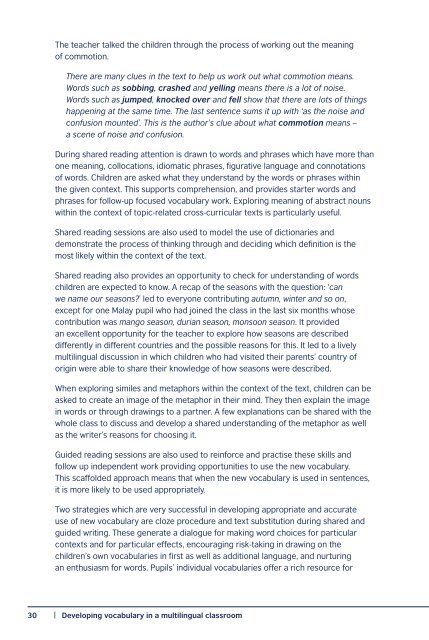Innovations in English language teaching for migrants and refugees
Innovations in English language teaching for migrants and refugees
Innovations in English language teaching for migrants and refugees
You also want an ePaper? Increase the reach of your titles
YUMPU automatically turns print PDFs into web optimized ePapers that Google loves.
The teacher talked the children through the process of work<strong>in</strong>g out the mean<strong>in</strong>g<br />
of commotion.<br />
There are many clues <strong>in</strong> the text to help us work out what commotion means.<br />
Words such as sobb<strong>in</strong>g, crashed <strong>and</strong> yell<strong>in</strong>g means there is a lot of noise.<br />
Words such as jumped, knocked over <strong>and</strong> fell show that there are lots of th<strong>in</strong>gs<br />
happen<strong>in</strong>g at the same time. The last sentence sums it up with ‘as the noise <strong>and</strong><br />
confusion mounted’. This is the author’s clue about what commotion means –<br />
a scene of noise <strong>and</strong> confusion.<br />
Dur<strong>in</strong>g shared read<strong>in</strong>g attention is drawn to words <strong>and</strong> phrases which have more than<br />
one mean<strong>in</strong>g, collocations, idiomatic phrases, figurative <strong>language</strong> <strong>and</strong> connotations<br />
of words. Children are asked what they underst<strong>and</strong> by the words or phrases with<strong>in</strong><br />
the given context. This supports comprehension, <strong>and</strong> provides starter words <strong>and</strong><br />
phrases <strong>for</strong> follow-up focused vocabulary work. Explor<strong>in</strong>g mean<strong>in</strong>g of abstract nouns<br />
with<strong>in</strong> the context of topic-related cross-curricular texts is particularly useful.<br />
Shared read<strong>in</strong>g sessions are also used to model the use of dictionaries <strong>and</strong><br />
demonstrate the process of th<strong>in</strong>k<strong>in</strong>g through <strong>and</strong> decid<strong>in</strong>g which def<strong>in</strong>ition is the<br />
most likely with<strong>in</strong> the context of the text.<br />
Shared read<strong>in</strong>g also provides an opportunity to check <strong>for</strong> underst<strong>and</strong><strong>in</strong>g of words<br />
children are expected to know. A recap of the seasons with the question: ‘can<br />
we name our seasons?’ led to everyone contribut<strong>in</strong>g autumn, w<strong>in</strong>ter <strong>and</strong> so on,<br />
except <strong>for</strong> one Malay pupil who had jo<strong>in</strong>ed the class <strong>in</strong> the last six months whose<br />
contribution was mango season, durian season, monsoon season. It provided<br />
an excellent opportunity <strong>for</strong> the teacher to explore how seasons are described<br />
differently <strong>in</strong> different countries <strong>and</strong> the possible reasons <strong>for</strong> this. It led to a lively<br />
multil<strong>in</strong>gual discussion <strong>in</strong> which children who had visited their parents’ country of<br />
orig<strong>in</strong> were able to share their knowledge of how seasons were described.<br />
When explor<strong>in</strong>g similes <strong>and</strong> metaphors with<strong>in</strong> the context of the text, children can be<br />
asked to create an image of the metaphor <strong>in</strong> their m<strong>in</strong>d. They then expla<strong>in</strong> the image<br />
<strong>in</strong> words or through draw<strong>in</strong>gs to a partner. A few explanations can be shared with the<br />
whole class to discuss <strong>and</strong> develop a shared underst<strong>and</strong><strong>in</strong>g of the metaphor as well<br />
as the writer’s reasons <strong>for</strong> choos<strong>in</strong>g it.<br />
Guided read<strong>in</strong>g sessions are also used to re<strong>in</strong><strong>for</strong>ce <strong>and</strong> practise these skills <strong>and</strong><br />
follow up <strong>in</strong>dependent work provid<strong>in</strong>g opportunities to use the new vocabulary.<br />
This scaffolded approach means that when the new vocabulary is used <strong>in</strong> sentences,<br />
it is more likely to be used appropriately.<br />
Two strategies which are very successful <strong>in</strong> develop<strong>in</strong>g appropriate <strong>and</strong> accurate<br />
use of new vocabulary are cloze procedure <strong>and</strong> text substitution dur<strong>in</strong>g shared <strong>and</strong><br />
guided writ<strong>in</strong>g. These generate a dialogue <strong>for</strong> mak<strong>in</strong>g word choices <strong>for</strong> particular<br />
contexts <strong>and</strong> <strong>for</strong> particular effects, encourag<strong>in</strong>g risk-tak<strong>in</strong>g <strong>in</strong> draw<strong>in</strong>g on the<br />
children’s own vocabularies <strong>in</strong> first as well as additional <strong>language</strong>, <strong>and</strong> nurtur<strong>in</strong>g<br />
an enthusiasm <strong>for</strong> words. Pupils’ <strong>in</strong>dividual vocabularies offer a rich resource <strong>for</strong><br />
30 | Develop<strong>in</strong>g vocabulary <strong>in</strong> a multil<strong>in</strong>gual classroom


